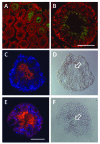Models of in vitro spermatogenesis
- PMID: 22553488
- PMCID: PMC3341244
- DOI: 10.4161/spmg.19383
Models of in vitro spermatogenesis
Abstract
Understanding the mechanisms that lead to the differentiation of male germ cells from their spermatogonial stem cells through meiosis to give rise to mature haploid spermatozoa has been a major quest for many decades. Unlike most other cell types this differentiation process is more or less completely dependent upon the cells being located within the strongly structured niche provided by mature Sertoli cells within an intact seminiferous epithelium. While much new information is currently being obtained through the application and description of relevant gene mutations, there is still a considerable need for in vitro models with which to explore the mechanisms involved. Not only are systems of in vitro spermatogenesis important for understanding the basic science, they have marked pragmatic value in offering ex vivo systems for the artificial maturation of immature germ cells from male infertility patients, as well as providing opportunities for the transgenic manipulation of male germ cells. In this review, we have summarized literature relating to simplistic culturing of germ cells, co-cultures of germ cells with other cell types, especially with Sertoli cells, cultures of seminiferous tubule fragments, and briefly mention the opportunities of xenografting larger testicular pieces. The majority of methods are successful in allowing the differentiation of small steps in the progress of spermatogonia to spermatozoa; few tolerate the chromosomal reduction division through meiosis, and even fewer seem able to complete the complex morphogenesis which results in freely swimming spermatozoa. However, recent progress with complex culture environments, such as 3-d matrices, suggest that possibly success is now not too far away.
Figures




Similar articles
-
Irradiation affects germ and somatic cells in prepubertal monkey testis xenografts.Mol Hum Reprod. 2017 Mar 1;23(3):141-154. doi: 10.1093/molehr/gax003. Mol Hum Reprod. 2017. PMID: 28130393
-
Testicular organoids: a new model to study the testicular microenvironment in vitro?Hum Reprod Update. 2018 Mar 1;24(2):176-191. doi: 10.1093/humupd/dmx036. Hum Reprod Update. 2018. PMID: 29281008
-
Surfing the wave, cycle, life history, and genes/proteins expressed by testicular germ cells. Part 1: background to spermatogenesis, spermatogonia, and spermatocytes.Microsc Res Tech. 2010 Apr;73(4):241-78. doi: 10.1002/jemt.20783. Microsc Res Tech. 2010. PMID: 19941293 Review.
-
In vitro differentiation of rat spermatogonia into round spermatids in tissue culture.Mol Hum Reprod. 2016 Sep;22(9):601-12. doi: 10.1093/molehr/gaw047. Epub 2016 Jul 18. Mol Hum Reprod. 2016. PMID: 27430551 Free PMC article.
-
A Review of New Technologies that may Become Useful for in vitro Production of Boar Sperm.Reprod Domest Anim. 2015 Jul;50 Suppl 2:61-70. doi: 10.1111/rda.12571. Reprod Domest Anim. 2015. PMID: 26174921 Review.
Cited by
-
VCAM1-α4β1 integrin interaction mediates interstitial tissue reconstruction in 3-D re-aggregate culture of dissociated prepubertal mouse testicular cells.Sci Rep. 2021 Sep 15;11(1):18332. doi: 10.1038/s41598-021-97729-y. Sci Rep. 2021. PMID: 34526555 Free PMC article.
-
Progress and future prospect of in vitro spermatogenesis.Oncotarget. 2017 Jul 27;8(39):66709-66727. doi: 10.18632/oncotarget.19640. eCollection 2017 Sep 12. Oncotarget. 2017. PMID: 29029549 Free PMC article. Review.
-
Sertolin mediates blood-testis barrier restructuring.Endocrinology. 2014 Apr;155(4):1520-31. doi: 10.1210/en.2013-1850. Epub 2014 Jan 27. Endocrinology. 2014. PMID: 24467744 Free PMC article.
-
Study of Tnp1, Tekt1, and Plzf Genes Expression During an in vitro Three-Dimensional Neonatal Male Mice Testis Culture.Iran Biomed J. 2018 Jul;22(4):258-63. doi: 10.22034/ibj.22.4.258. Epub 2018 Feb 4. Iran Biomed J. 2018. PMID: 29397043 Free PMC article.
-
Xenografting of isolated equine (Equus caballus) testis cells results in de novo morphogenesis of seminiferous tubules but not spermatogenesis.Andrology. 2017 Mar;5(2):336-346. doi: 10.1111/andr.12308. Epub 2017 Feb 3. Andrology. 2017. PMID: 28160442 Free PMC article.
References
-
- Martinovitch PN. Development in vitro of the mammalian gonad. Nature. 1937;139:413. doi: 10.1038/139413a0. - DOI
LinkOut - more resources
Full Text Sources
